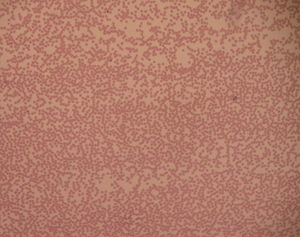Neutropenia
| Neutropenia | |
|---|---|
 |
|
| Blood film with a striking absence of neutrophils, leaving only red blood cells and platelets | |
| Classification and external resources | |
| Specialty | Infectious disease |
| ICD-10 | D70 |
| ICD-9-CM | 288.0 |
| DiseasesDB | 8994 |
| MedlinePlus | 007230 |
| eMedicine | med/1640 |
| MeSH | D009503 |
Neutropenia or neutropaenia, is an abnormally low concentration of neutrophils (a type of white blood cell) in the blood. Neutrophils make up the majority of circulating white blood cells and serve as the primary defense against infections by destroying bacteria, bacterial fragments and immunoglobulin-bound viruses in the blood. Patients with neutropenia are more susceptible to bacterial infections and, without prompt medical attention, the condition may become life-threatening (neutropenic sepsis).
Neutropenia can be acute (temporary) or chronic (long lasting). The term is sometimes used interchangeably with "leukopenia" ("deficit in the number of white blood cells").
Signs and symptoms of neutropenia include fever, painful swallowing, gingival pain, skin abscesses, and otitis. These symptoms may exist because individuals with neutropenia often have infection Children may show signs of irritability, and poor feeding.Hypotension has also been observed.
The causes of neutropenia can be divided between problems that are transient and those that are chronic . Causes can be divided into these groups:
Gram-positive bacteria are present in 60-70% of bacterial infections. There are serious concerns regarding antibiotic-resistant organisms. These would include as methicillin-resistant Staphylococcus aureus (MRSA) or vancomycin-resistant Enterococcus (VRE).)
...
Wikipedia
